Cats
Can Cats Drink Coffee Safely?
Nervous about letting your cat near your morning brew?
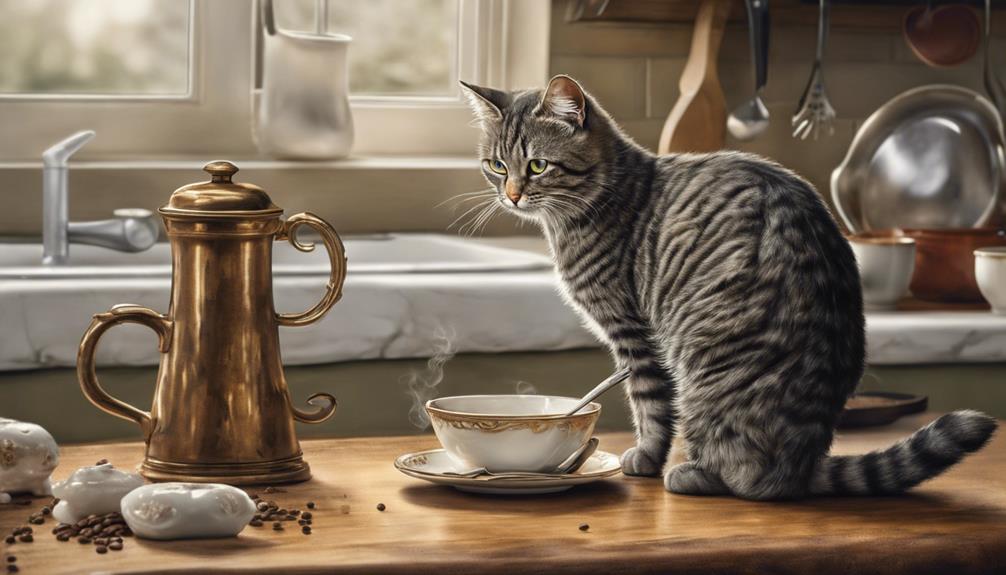
Cats cannot drink coffee safely. Even a small amount is highly toxic to them, leading to severe health risks and potential poisoning. Symptoms of caffeine toxicity in cats include hyperactivity and increased heart rate. Immediate veterinary care is essential if ingestion occurs. Prevent access to coffee and opt for safe alternatives like fresh water or cat-friendly milk. Cats' lower tolerance for caffeine makes them vulnerable to toxicity. Factors like breed and health impact cats' response to caffeine. Understanding the risks can help safeguard your feline friend's well-being. Additionally, considering decaffeinated options and sugars' impact on cats' health is crucial.
Key Takeaways
- Cats should never drink coffee due to extreme sensitivity to caffeine.
- Even small amounts of coffee can lead to poisoning in cats.
- Symptoms of caffeine poisoning in cats include hyperactivity and increased heart rate.
- Immediate veterinary care is necessary for distressed cats.
- Prevention is crucial: keep coffee away from cats to safeguard their health.
Risks of Cats Drinking Coffee
Drinking coffee poses serious risks to cats due to the toxic effects of caffeine. Cats are highly sensitive to caffeine, and even a small amount can lead to poisoning, causing a range of health issues.
The ASPCA strongly advises against giving coffee to pets, emphasizing the dangers associated with the toxic methylxanthines found in this popular beverage. If a cat ingests coffee accidentally, it can result in caffeine poisoning, manifesting as hyperexcitability, vomiting, and an increased heart rate.
These symptoms can escalate to more severe complications like heart problems and seizures, highlighting the critical need to keep coffee and other caffeine-containing products away from our feline companions. Remember, what might seem like a harmless treat to us can have detrimental effects on our beloved cats.
Being mindful of their unique physiology and vulnerabilities is vital in ensuring their well-being and longevity.
Caffeine Sensitivity in Cats
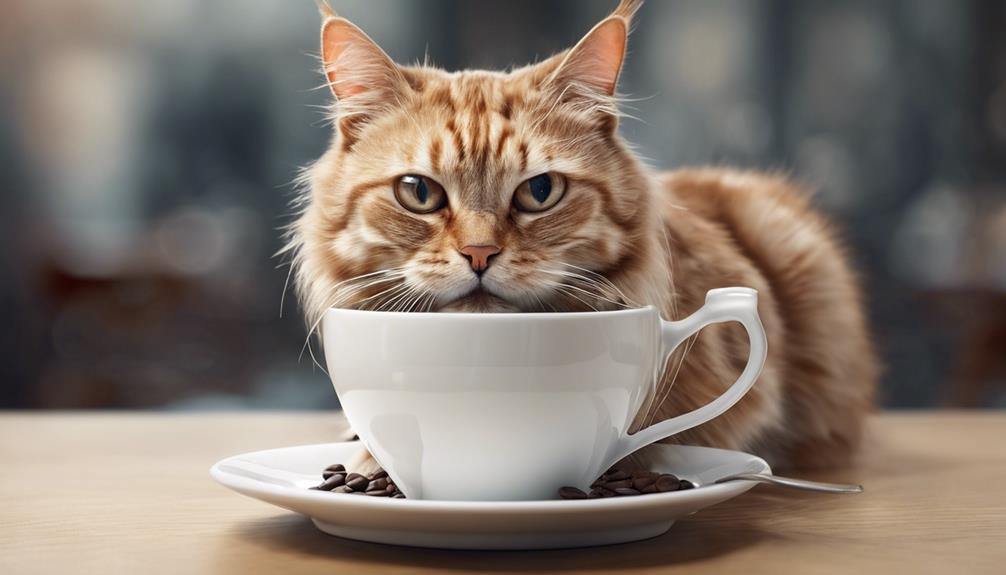
Cats have a lower tolerance for caffeine compared to humans, which means even small amounts can pose potential health risks.
It's important to be cautious with coffee, tea, or soda around cats, as even a few licks can be harmful.
To keep our feline friends safe, it's best to explore safe alternatives and prevent access to coffee or other caffeinated drinks.
Cat Caffeine Tolerance
Although humans may enjoy their morning cup of coffee, cats have an extreme sensitivity to caffeine, making it important to keep all caffeinated products away from them.
Cats' caffeine sensitivity can lead to severe health issues, including caffeine toxicity, even with small amounts. Due to their low tolerance and inefficient caffeine metabolism, cats can quickly show symptoms like hyperactivity, restlessness, and increased heart rate when exposed to caffeine.
It's essential to understand that what may seem harmless to us can pose a significant risk to our feline friends. Keeping coffee and other caffeinated products out of reach of cats is a simple yet crucial way to secure their well-being and prevent any potential harm.
Potential Health Risks
Given their heightened sensitivity to caffeine, it's important to understand the potential health risks that cats face when exposed to even small amounts of coffee. Cats can experience caffeine poisoning, which can manifest in symptoms like increased heart rate, restlessness, and even seizures.
Just one or two licks of coffee can be harmful to our feline friends due to their low tolerance for caffeine. Unused coffee grounds, beans, or tea bags pose an even higher risk of severe toxicity in cats. It's crucial to keep coffee and related products out of reach to prevent accidental ingestion.
Cats may be drawn to coffee due to the milk or cream content, so extra caution is necessary to safeguard their health. Let's prioritize our cats' well-being by keeping them away from coffee to safeguard they stay healthy and happy.
Safe Alternatives for Cats
To guarantee our feline companions' well-being and health, it's vital to explore safe alternatives for them considering their sensitivity to caffeine. When it comes to keeping our cats hydrated and happy, we can opt for the following safe alternatives:
- Fresh Water: Providing clean, fresh water is essential to make sure proper hydration for our cats without any risks associated with caffeine.
- Cat-Friendly Milk: Opt for specially formulated cat milk that's safe for feline consumption and can be a tasty alternative to caffeinated beverages.
- Specialized Cat Treats: Treats designed specifically for cats can be a great way to reward them without exposing them to the dangers of caffeine sensitivity.
Symptoms of Caffeine Toxicity
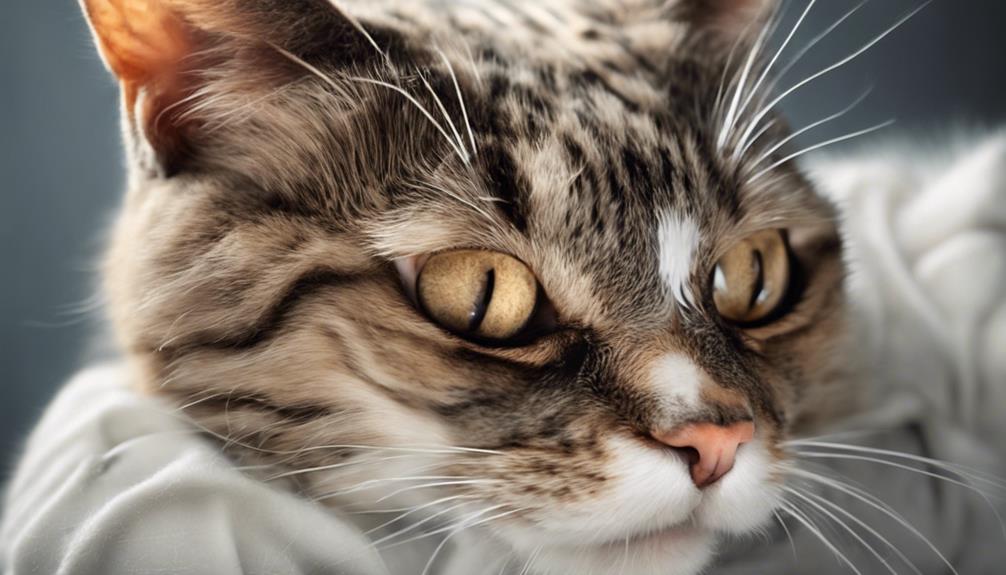
Cats can exhibit various symptoms of caffeine toxicity, such as increased heart rate, restlessness, and seizures. These signs may also include vomiting, diarrhea, agitation, and rapid breathing.
Monitoring for these effects and seeking prompt veterinary care is essential for the well-being of our feline companions.
Caffeine Poisoning Signs
Recognizing the symptoms of caffeine poisoning in cats promptly is vital for ensuring timely veterinary care. When it comes to signs of caffeine poisoning in your feline friend, keep an eye out for the following:
- Increased heart rate and hyperactivity can signal a potential issue.
- Vomiting, diarrhea, and tremors may indicate caffeine toxicity in cats.
- Agitation and seizures are serious symptoms that require immediate attention.
Being vigilant as pet owners can help prevent the dangers associated with caffeine ingestion. If you notice any of these symptoms, it's essential to seek veterinary care promptly to guarantee the well-being of your beloved cat.
Effects on Feline Health
Indications of caffeine toxicity in felines encompass a range of symptoms that warrant immediate attention from veterinary professionals. Symptoms such as hyperexcitability, vomiting, increased heart rate, seizures, and, in severe cases, even death can occur due to caffeine ingestion. Different coffee types have varying caffeine levels, influencing the risk of toxicity in cats.
The effects of caffeine ingestion in cats can manifest within hours of exposure. If a cat shows signs of caffeine poisoning, prompt veterinary care is essential. Treatment may involve induced vomiting, administration of intravenous fluids, medications, or hospitalization.
While cats are less prone to caffeine toxicity than dogs, any suspicion of ingestion should be taken seriously to guarantee the well-being of our feline companions.
Immediate Actions After Coffee Ingestion

Upon noticing that a cat has ingested coffee, swift action is important to prevent further harm and monitor for potential signs of caffeine toxicity. Here are the immediate actions to take:
- Remove the cat from the coffee area: This prevents additional consumption and reduces the risk of further poisoning.
- Monitor closely for signs of distress: Pay attention to any unusual behavior within the next 30-60 minutes. Look out for symptoms like restlessness or increased heart rate.
- Contact a veterinarian promptly: If you notice any signs of caffeine poisoning, such as vomiting, tremors, or seizures, it's essential to seek professional help immediately. Don't attempt to treat the cat on your own as vet intervention is necessary for proper care.
Importance of Seeking Veterinary Help

Seeking prompt veterinary assistance is vital if a cat displays symptoms of caffeine poisoning after consuming coffee. When it comes to our feline friends, acting quickly can make a significant difference in their recovery. Veterinarians are equipped to provide the necessary care, such as inducing vomiting, administering fluids, or offering medications to counteract caffeine toxicity.
Monitoring the cat closely post-ingestion and following professional guidance are essential steps in ensuring a positive outcome. Delaying veterinary help can worsen the cat's condition and lead to severe health issues.
Preventing Future Incidents

After addressing the importance of seeking veterinary help for cats who've ingested coffee, the focus now shifts to preventing future incidents to safeguard our feline companions' well-being. Here are three essential steps to guarantee our cats stay safe:
- Store coffee securely: Keep coffee in a place that's inaccessible to cats. Consider using sealed containers or cabinets to store coffee grounds, beans, or brewed coffee safely away from curious paws.
- Educate household members: It's vital to inform everyone in the household about the hazards of coffee for cats. By raising awareness, we can all work together to create a safe environment for our furry friends.
- Discourage cat access: Take preventive measures such as not leaving coffee cups unattended and using deterrents like bitter apple spray on coffee-related items. These actions can help deter cats from trying to access coffee, reducing the risk of accidental ingestion.
Let's collaborate to keep our cats safe and healthy!
Coffee Consumption Effects on Cats
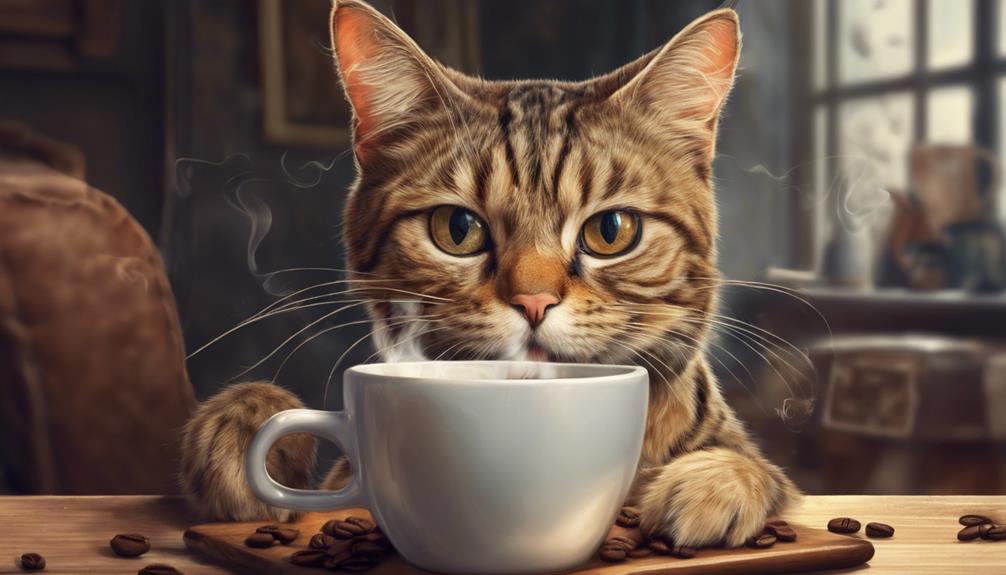
Discussing the effects of coffee consumption on cats reveals the potential risks associated with caffeine exposure for our feline companions. Caffeine, present in coffee, can have significant impacts on cats, affecting their heart rate, need to urinate, and sensory stimulation due to the caffeine and theobromine content. Symptoms of caffeine ingestion in cats may manifest as restlessness, hyperactivity, and could rapidly escalate depending on individual health factors.
Ground coffee is particularly hazardous for cats because of its high toxicity level from caffeine content. Ingesting caffeine can result in severe internal issues and, in extreme cases, even death for our beloved pets. Being mindful of these effects is essential in safeguarding our feline friends from the dangers of coffee consumption.
Vets Approach to Coffee Ingestion

When addressing coffee ingestion in cats, veterinarians emphasize the importance of immediate action to prevent caffeine poisoning. Here's how vets approach coffee ingestion in felines:
- Quick Response: Time is essential in preventing caffeine poisoning. Vets recommend acting promptly to minimize the risks associated with coffee ingestion in cats.
- Symptom Monitoring: After coffee ingestion, monitoring the cat for symptoms of caffeine poisoning is crucial. Any signs of distress should prompt immediate veterinary care to guarantee the cat's well-being.
- Tailored Treatment: Treatment for caffeine poisoning may involve inducing vomiting and providing fluids. Vets assess the cat's health, the amount of coffee ingested, and the type of coffee consumed to determine the most effective course of action. Tailored veterinary care is necessary for a successful recovery from coffee exposure in cats.
Cats Recovery From Coffee Exposure
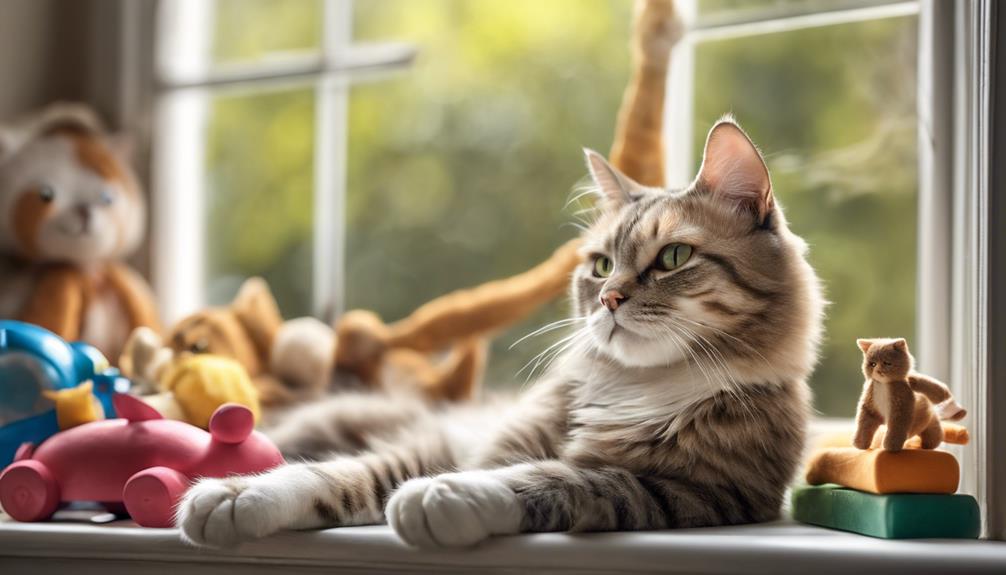
When it comes to cats recovering from coffee exposure, it's essential to take into account their caffeine sensitivity and the symptoms of coffee toxicity they may exhibit.
While most cats bounce back well from small coffee doses, severe cases might necessitate immediate veterinary attention.
Monitoring your feline friend closely post-exposure is key to catching any signs of distress early on.
Cats Caffeine Sensitivity
After coffee exposure, cats can recover with proper veterinary care and monitoring, depending on factors such as the amount consumed, the cat's health, and the type of coffee ingested. When dealing with cats' caffeine sensitivity, it's crucial to comprehend the effects of caffeine on their delicate systems.
Here are some key points to take into account:
- Caffeine sensitivity: Cats can be more sensitive to caffeine than humans, making even small amounts harmful to their pets.
- Effects of caffeine: Caffeine can lead to a range of symptoms in cats, from mild agitation to severe toxicity.
- Harmful to their pets: Owners must be cautious as excessive caffeine can have detrimental effects on their beloved feline companions.
Understanding these factors can help safeguard the well-being of our furry friends.
Symptoms of Coffee Toxicity
Considering the potential symptoms of coffee toxicity in cats, it's important to recognize the signs that indicate recovery from coffee exposure.
After ingesting coffee, cats may exhibit hyperactivity, restlessness, vomiting, and an increased heart rate. These symptoms signal the need for immediate attention and monitoring. If your feline friend shows distress or behaves abnormally after coffee consumption, it's vital to seek veterinary care promptly.
Recovery from coffee exposure varies depending on the amount consumed and the type of coffee ingested. Close observation and appropriate treatment can aid in the cat's recovery process.
Coffees Lethal Potential for Cats
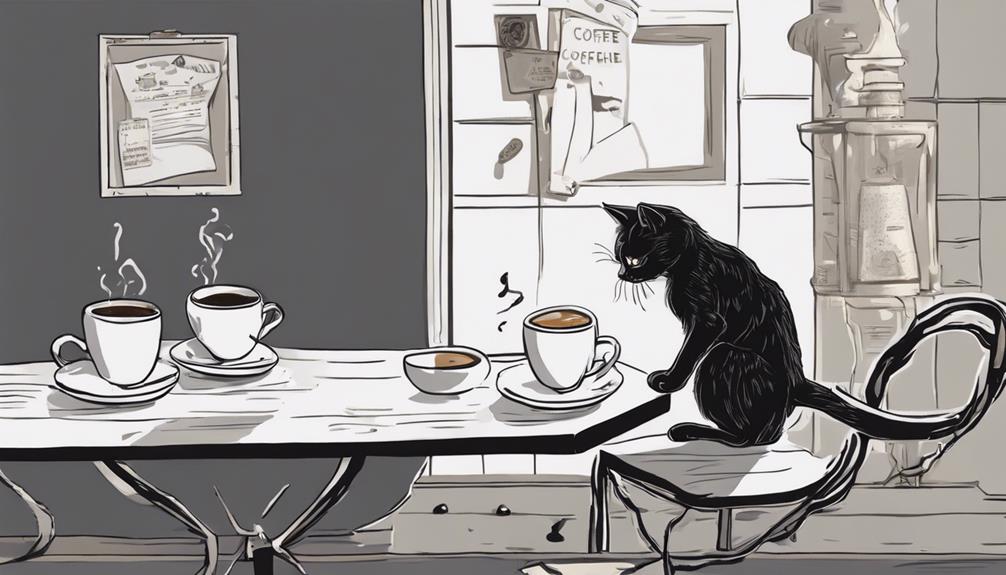
Cats face a significant risk of poisoning from coffee due to their sensitivity to caffeine, with even small amounts of espresso potentially leading to severe symptoms. When it comes to coffee's lethal potential for cats:
- Mild Signs from Ingesting Instant Coffee Grounds: Just 3 teaspoons of instant coffee grounds can set off mild symptoms in cats, indicating the potency of caffeine even in small doses.
- Severe Symptoms from Coffee Grounds: Ingesting 10 teaspoons of instant coffee grounds can escalate into severe symptoms for cats, underscoring the danger coffee poses to our feline friends.
- Espresso's High Caffeine Levels: Espresso, with its higher caffeine content, poses an increased risk to cats compared to regular coffee. This emphasizes the importance of keeping all forms of coffee away from cats to prevent accidental ingestion and subsequent harm.
Understanding the potential dangers of coffee for cats is vital for responsible pet ownership. Keeping these facts in mind is necessary to safeguard the safety and well-being of our beloved feline companions.
Coffee Grounds and Cat Safety
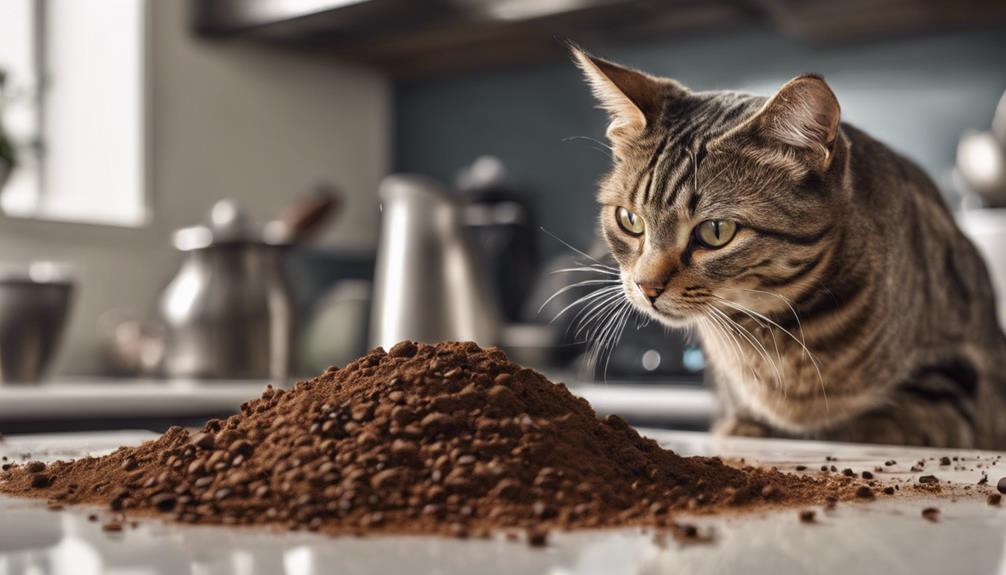
When handling coffee grounds around feline companions, vigilance is crucial to prevent accidental ingestion and potential harm. Cats are naturally curious creatures and may be attracted to the strong scent and texture of coffee grounds. However, it's essential to keep these grounds out of reach, as even a small amount ingested can lead to severe toxicity due to their concentrated caffeine content. Compared to brewed coffee, coffee grounds pose a higher risk of poisoning in cats.
| Risk of Coffee Grounds | Effects on Cats | Action to Take |
|---|---|---|
| High | Adverse effects | Contact pet poison helpline |
If you suspect your cat has ingested coffee grounds, immediate veterinary attention is essential to prevent severe health complications. Remember, prevention is key when it comes to keeping our feline friends safe from potential dangers like coffee grounds.
Decaffeinated Coffee Considerations

After consuming decaffeinated coffee, cats may still experience mild toxicity due to the remaining caffeine content present in the beverage. It's crucial to be cautious and avoid exposing your feline friends to decaffeinated coffee due to the potential health risks associated with its caffeine content.
- Even small amounts of decaffeinated coffee can lead to symptoms of caffeine poisoning in cats, putting their health at risk.
- Decaffeinated coffee still contains some caffeine, albeit in lower amounts compared to regular coffee, which can cause mild upsets in cats.
- It is advisable to steer clear of giving any type of coffee, including decaffeinated, to cats to prevent any adverse effects on their well-being.
Sugars Impact on Cats and Coffee

When it comes to cats and coffee, the impact of sugars is significant. Excessive sugar in coffee can lead to weight gain, dental problems, and digestive issues in our feline friends.
Be mindful of the risks associated with sugar consumption for cats when considering sharing your coffee with them.
Sugar and Cat Health
Sugar in coffee poses potential risks to the health of cats, including weight gain, diabetes, and dental issues. Cats aren't naturally drawn to sugary flavors, and their bodies aren't equipped to process high levels of sugar. Here are three ways sugar can impact your feline friend's health:
- Weight Gain: Excessive sugar consumption can lead to unhealthy weight gain in cats, putting strain on their joints and organs.
- Diabetes: A diet high in sugar can disrupt a cat's metabolism, increasing the risk of developing diabetes over time.
- Dental Issues: Sugary substances like coffee can contribute to dental problems in cats, such as tooth decay and gum disease.
To keep your cat healthy and happy, it's best to avoid giving them sugary treats like coffee.
Caffeine Sensitivity in Cats
Cats' sensitivity to caffeine makes it important to be cautious about their exposure to coffee and related products, considering the potential risks to their health. Unlike humans, cats lack the necessary enzymes to efficiently process caffeine, making even small amounts harmful to their nervous system. The effects of caffeine on cats can lead to serious health issues, affecting their heart and overall well-being.
Additionally, the sugar content in coffee can also pose dangers to cats, exacerbating the potential harm. To safeguard our feline friends, it's essential to keep all caffeinated products, including coffee, out of their reach. By being mindful of their sensitivity to caffeine, we can help guarantee our cats lead healthy and happy lives free from unnecessary risks.
Risks of Coffee
As pet owners, we must be diligent about the risks associated with coffee consumption for our furry companions. When it comes to cats and coffee, there are several reasons why it's harmful:
- Caffeine Content: Coffee contains caffeine, which can have serious effects on cats' health, including heart problems and seizures.
- Harmful Additives: Coffee often contains harmful levels of milk and sugar, which lack nutritional value and can be detrimental to cats.
- Toxicity Concerns: The ASPCA warns against giving coffee to pets due to toxic methylxanthines present in coffee, which can be harmful to cats.
It's important to keep coffee and other caffeinated products away from our feline friends to safeguard their well-being.
Caffeine Poisoning Signs in Cats
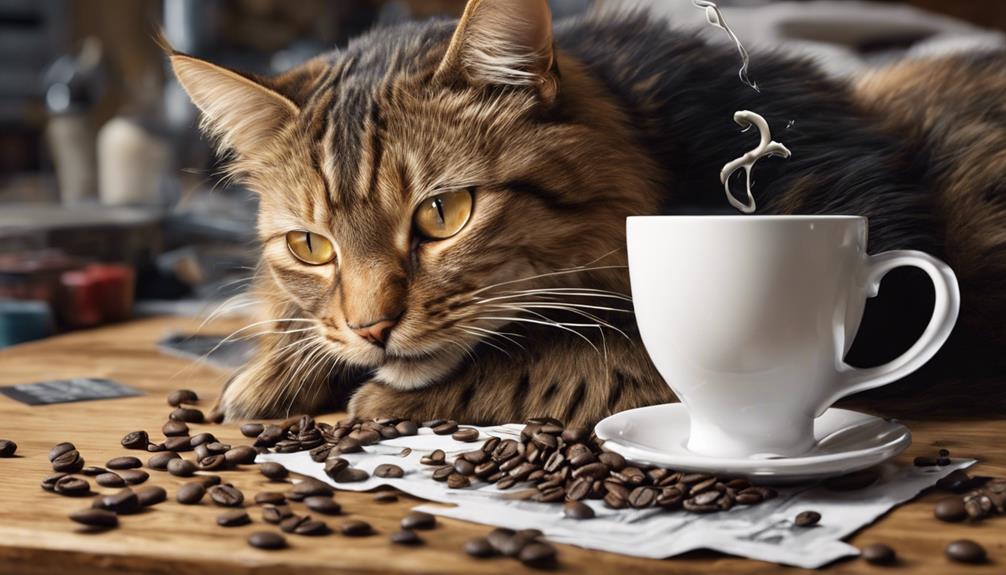
Detecting caffeine poisoning signs in cats early is vital for their prompt treatment and positive prognosis. If your feline friend has ingested toxic levels of caffeine, watch out for increased heart rate, restlessness, and hyperactivity as initial signs.
Vomiting, tremors, and seizures may also occur, indicating a serious situation that necessitates immediate veterinary attention. Monitoring for symptoms like agitation, rapid breathing, and twitching can help identify toxicity early on.
Remember, recognizing these signs promptly can greatly impact your cat's treatment outcome. It's essential to act swiftly and seek professional help if you suspect caffeine poisoning in your beloved pet. By staying vigilant and informed about these warning signs, you can safeguard the well-being and health of your furry companion.
Your quick response can make a significant impact in your cat's recovery from caffeine poisoning.
Factors Influencing Cats Caffeine Response
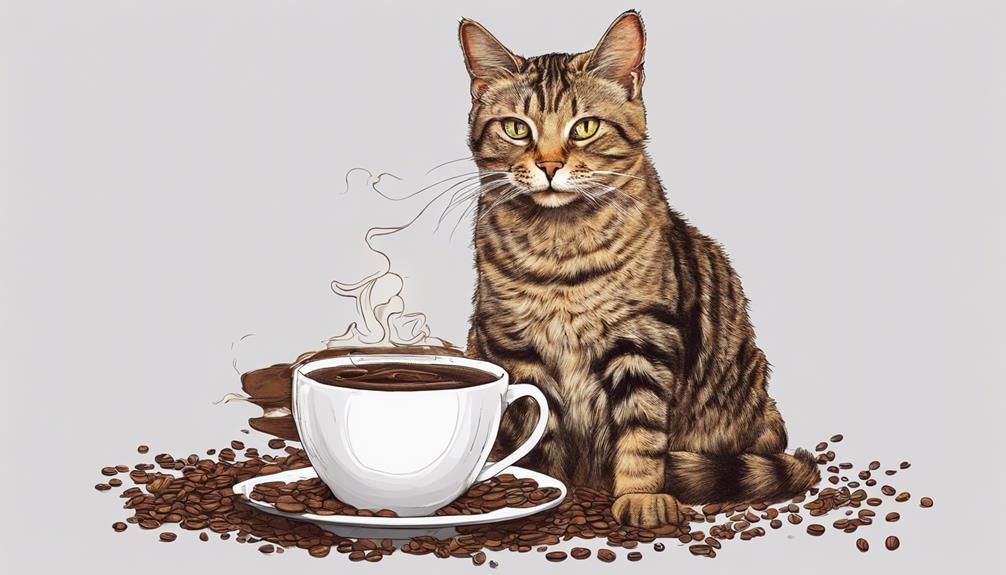
What factors influence how cats respond to caffeine ingestion?
Cats' bodies react differently based on various factors such as caffeine levels, breed predispositions, and overall health condition.
- Caffeine Levels: Cats' bodies can be sensitive to even small amounts of caffeine, especially those with underlying health issues. High caffeine content can quickly lead to severe reactions in cats with heart problems or lactose intolerance.
- Breeds: Certain breeds like Siamese, Himalayan, Siberian, Bengal, and Ragdoll are known to be more curious and likely to explore coffee. Their inquisitive nature may increase the chances of caffeine ingestion.
- Health Condition: Monitoring caffeine intake becomes essential, as it can greatly impact cats' well-being. Understanding the amount ingested and the type of caffeine consumed is vital for the safety of your feline companion. Factors like breed, health condition, and the specific caffeine type play significant roles in determining how a cat will respond to caffeine ingestion.
Frequently Asked Questions
What Happens if a Cat Drinks Coffee?
If a cat drinks coffee, it can experience severe symptoms like hyperexcitability, vomiting, rapid heart rate, and seizures. Various coffee types have different caffeine levels, impacting the toxicity risk. Immediate effects appear within hours, necessitating vet care.
Can Cats Have a Little Bit of Coffee?
We absolutely should not give cats any coffee. Even a small amount can be harmful due to the caffeine content. It's important to prioritize our feline friends' health and avoid any risks associated with coffee consumption.
How Much Coffee Is Safe for Cats?
Drinking coffee is unsafe for cats. Even a small amount can be harmful due to their sensitivity to caffeine. If a cat consumes coffee, immediate veterinary care is crucial to prevent serious health issues.
Why Does My Cat Want to Drink My Coffee?
Yearning for your coffee, feline friends may be fascinated by the fragrance, warmth, or milk it holds. However, it's unsafe for them. We must deter this behavior and offer them fresh water instead.
Conclusion
To sum up, while cats may be curious about coffee, it's best to keep this beverage out of their reach. Caffeine can pose serious risks to our feline friends, leading to symptoms of toxicity and potential poisoning.
Remember, prevention is key to keeping your cat safe and healthy. So next time you reach for a cup of coffee, make sure to keep it away from your curious cat's paws!
Paul’s love for animals knows no bounds. As a dedicated writer and animal lover, Paul brings a unique perspective to our team. His firsthand experiences with various animals enrich our content and provide valuable insights into their behavior and needs. Whether he’s sharing tips for pet care or shedding light on pressing conservation issues, Paul’s passion for animals shines through in everything he does.
Cats
Do Cats Get Bored?
Uncover the subtle signs of cat boredom and learn how to keep your feline friend entertained and happy.

Cats can get bored. Signs like excessive grooming, meowing more, or ignoring toys may indicate boredom. Providing mental and physical stimulation, interactive toys, and playtime can help combat it. Observation is key to spotting boredom-related changes. Lack of activity, restricted space, and ignored instincts can trigger boredom. Stress relief through play and a stimulating environment are vital. Preventive measures like varied toys, play routines, and social interaction can keep cats engaged. Remember, understanding boredom cues is essential for your feline's well-being.
Key Takeaways
- Cats do get bored, leading to behavioral issues.
- Signs of cat boredom include excessive grooming and disinterest in toys.
- To prevent boredom, provide mental stimulation and interactive play.
- Boredom can impact a cat's health, leading to stress and obesity.
- Enriching the environment with toys and activities helps combat boredom.
Signs of Cat Boredom
Do cats exhibit specific signs when they're feeling bored? Absolutely! Cats can be quite expressive when they're feeling unstimulated. Excessive grooming, destructive behavior like scratching furniture, and increased vocalization are common signs of cat boredom. You might notice your feline friend showing disinterest in toys they usually enjoy or sleeping more than usual. These behaviors are their way of telling us that they need more mental and physical stimulation.
Moreover, factors such as a lack of playtime, social interaction, and vertical space can contribute to cat boredom. It's crucial to ponder medical issues as well, as they could be causing your cat's boredom. By being attentive to these signs and addressing the root cause, you can help alleviate your cat's boredom.
Understanding Cat Boredom
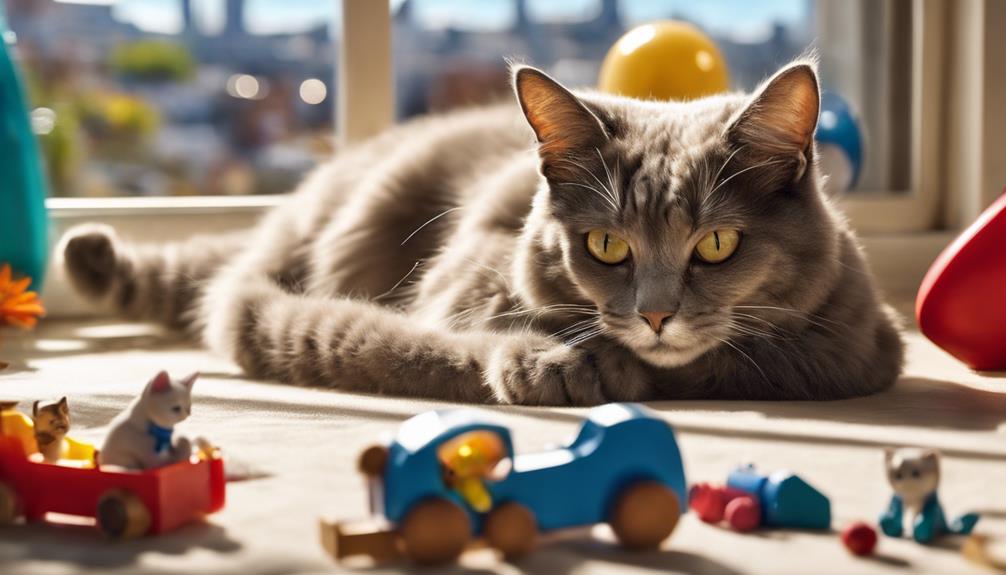
Cat boredom is a real issue that can affect our feline friends when they lack mental and physical stimulation. Signs of boredom in cats can range from restlessness to aggression towards other pets.
To combat cat boredom, providing toys, interactive games, and opportunities for indoor foraging experiences can keep our cats engaged and content.
Signs of Cat Boredom
Recognizing the signs of boredom in cats is essential for ensuring their overall well-being and happiness. Cats may exhibit signs such as excessive grooming, lack of interest in toys, lack of vertical space, and a decrease in their usual playful behavior. Below is a table summarizing common signs of cat boredom:
| Signs of Cat Boredom | Description |
|---|---|
| Excessive grooming | Cats may over-groom themselves, leading to skin irritation. |
| Lack of interest in toys | Cats show disinterest in their usual toys or playthings. |
| Lack of vertical space | Cats may seek higher spaces if they feel confined. |
| Interactive toys | Cats benefit from toys that engage their minds and bodies. |
Understanding these signs can help address your cat's boredom and improve their quality of life.
Combatting Cat Boredom
Understanding the underlying causes of cat boredom is essential in combatting this issue and promoting a happier feline companion. To keep your cat mentally stimulated, provide a variety of engaging toys and interactive games. Spending quality time engaging in play sessions and showing affection can also alleviate boredom-related behaviors.
Creating indoor foraging experiences by hiding treats around the house is another effective way to prevent boredom. By keeping your cat mentally and physically stimulated through these activities, you can help prevent boredom and promote their overall well-being. Remember, a happy and entertained cat isn't only a joy to be around but also likely to exhibit fewer destructive behaviors associated with boredom.
Behavioral Indicators of Cat Boredom

Identifying behavioral indicators of cat boredom can help pet owners address their feline companions' mental and physical well-being effectively. When our cats lack mental stimulation, they may exhibit signs of boredom such as excessive grooming, destructive behavior, or increased vocalization. Keep an eye out for a disinterest in interactive toys and an increase in sleeping hours; these could be subtle indicators that your cat needs more engagement.
To combat boredom, consider providing a range of interactive toys that challenge their minds and encourage physical activity. Additionally, creating an enriched environment with spaces to climb, hide, and explore can greatly benefit their well-being. Remember, insufficient playtime, limited social interaction, and a lack of vertical space can contribute to your cat's boredom.
Identifying Boredom in Cats
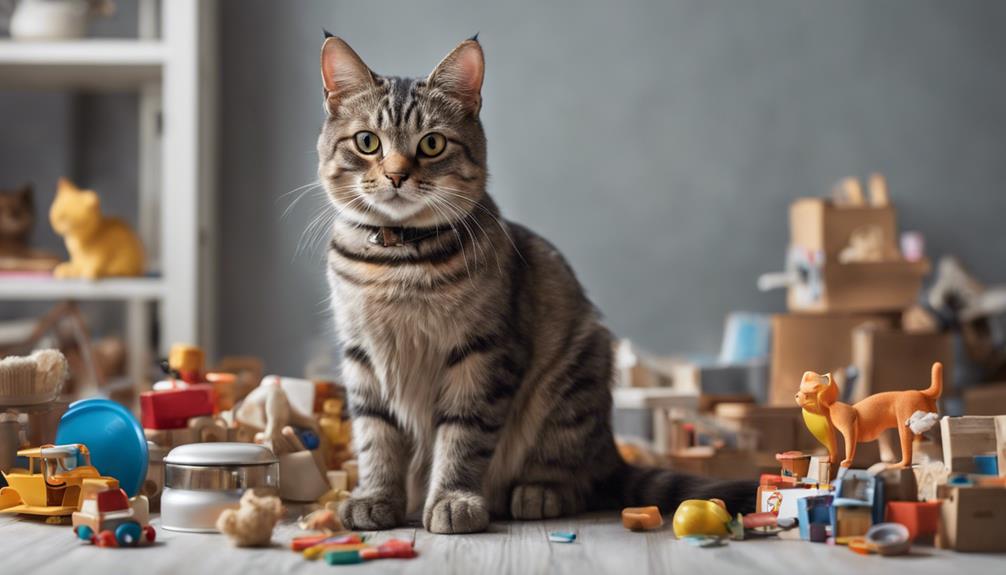
When it comes to cats, recognizing signs of boredom is crucial to their well-being. Excessive grooming, destructive behavior, increased vocalization, and lack of interest in toys are common indicators.
Signs of Cat Boredom
Excessive grooming, destructive behavior, and increased vocalization are clear indicators of cat boredom. Cats may also display disinterest in toys and sleep more than usual when they lack mental and physical stimulation. Insufficient playtime, lack of social interaction, and underlying health problems can contribute to your feline friend feeling bored. To help keep your cat engaged and content, it's crucial to observe these signs of cat boredom and take action. Below is a table summarizing common signs of cat boredom:
| Signs of Cat Boredom |
|---|
| Excessive Grooming |
| Destructive Behavior |
| Increased Vocalization |
| Lack of Interest in Toys |
| Excessive Sleeping |
Preventing Cat Boredom
To prevent cat boredom, guaranteeing a stimulating environment and regular interactive play sessions are vital. Cats can exhibit signs of boredom like excessive grooming, destructive behaviors, or lack of interest in toys when not adequately engaged.
Providing interactive toys and participating in regular playtime can help keep your feline friend entertained and mentally stimulated. Creating an enriched environment with scratching posts, climbing structures, and hiding spots can also prevent boredom.
If possible, considering companion cats for social interaction can further alleviate boredom and enhance your cat's well-being. Recognizing and addressing boredom in cats is essential for their happiness and overall quality of life.
Cat Boredom Triggers
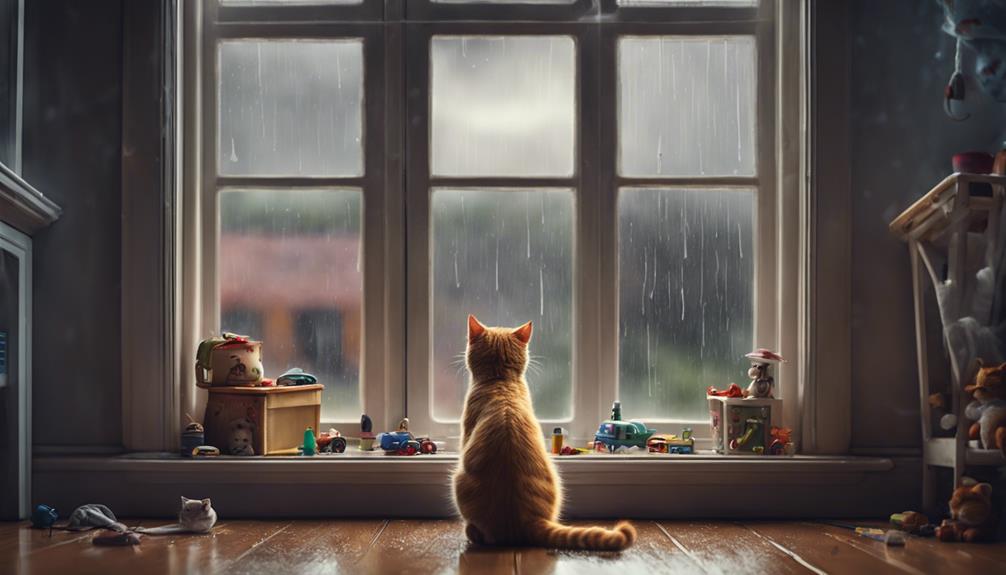
Cat boredom can be triggered by a lack of activity and stimulation. Indoor cats, with their limited opportunities for natural behaviors like hunting, are especially prone to mental stagnation. Signs of boredom in cats can manifest through destructive behavior or excessive sleeping. To prevent this, it's essential to understand the triggers that lead to feline boredom. Here are some key factors that can contribute to cat boredom:
| Cat Boredom Triggers | Examples |
|---|---|
| Lack of physical activity | Limited playtime or exercise opportunities |
| Inadequate mental stimulation | Few interactive toys or puzzles |
| Restricted environment exploration | Confinement to a small space or lack of vertical territory |
| Suppressed hunting instincts | Lack of opportunities to chase or 'hunt' toys |
Environmental Factors in Cat Boredom
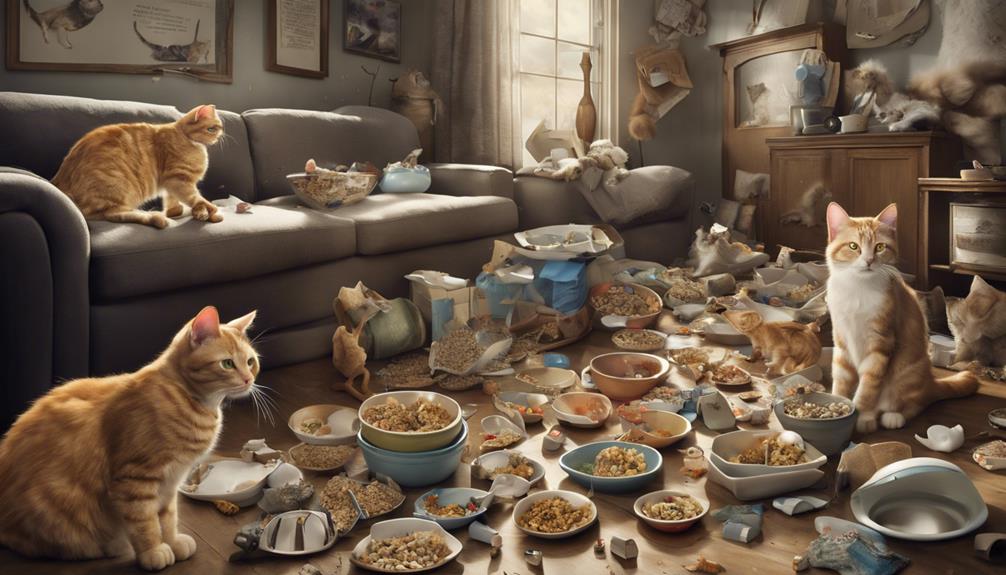
Cat boredom can often be linked to environmental factors such as lack of vertical spaces, hiding spots, and engaging toys.
Insufficient playtime and limited social interaction can also contribute to a cat feeling bored.
Creating a stimulating indoor environment with interactive toys and establishing a routine can help prevent boredom in our feline friends.
Cat Toys and Enrichment
Engaging cats with interactive toys and enriching their environment with climbing structures and perches can effectively combat boredom by stimulating their natural instincts and providing mental and physical exercise. Interactive toys, such as puzzle feeders and fishing rod toys, tap into their hunting instincts, preventing boredom. Climbing structures, scratching posts, and window perches offer opportunities for physical activity and mental stimulation. To maintain interest, rotating and introducing new toys regularly can keep cats engaged. Here is a helpful table to showcase some essential cat toys and enrichment options:
| Cat Toys | Enrichment |
|---|---|
| Puzzle feeders | Climbing structures |
| Fishing rod toys | Scratching posts |
| Window perches |
Interactive Playtime Routines
Implementing diverse playtime routines incorporating environmental enhancements is crucial for combating cat boredom and promoting mental stimulation. Engaging in interactive play sessions with toys like fishing rod toys and puzzle feeders helps satisfy a cat's natural hunting instincts while providing necessary exercise.
Creating a variety of play options keeps cats entertained and mentally engaged, preventing boredom. Establishing a routine for interactive play allows cats to anticipate and eagerly participate in engaging activities. Additionally, incorporating environmental factors such as climbing structures, window perches, and cat grass enriches a cat's surroundings, contributing to mental and physical stimulation.
Indoor Environment Stimulation
In our homes, creating a stimulating indoor environment plays a crucial role in preventing cat boredom and ensuring our feline companions lead fulfilling lives. Indoor cats, lacking the opportunity to engage their natural instincts, are more prone to boredom. Signs of boredom in cats can manifest as restlessness or excessive grooming.
To combat this, it's important to provide mental stimulation through climbing structures, scratching posts, and interactive toys. Including hiding spots, puzzle feeders, and dedicated playtime can also alleviate boredom-related behaviors in indoor cats. By enriching their indoor environment, we can help our cats stay mentally engaged and content, promoting their overall well-being and happiness.
Cat Boredom and Health Issues
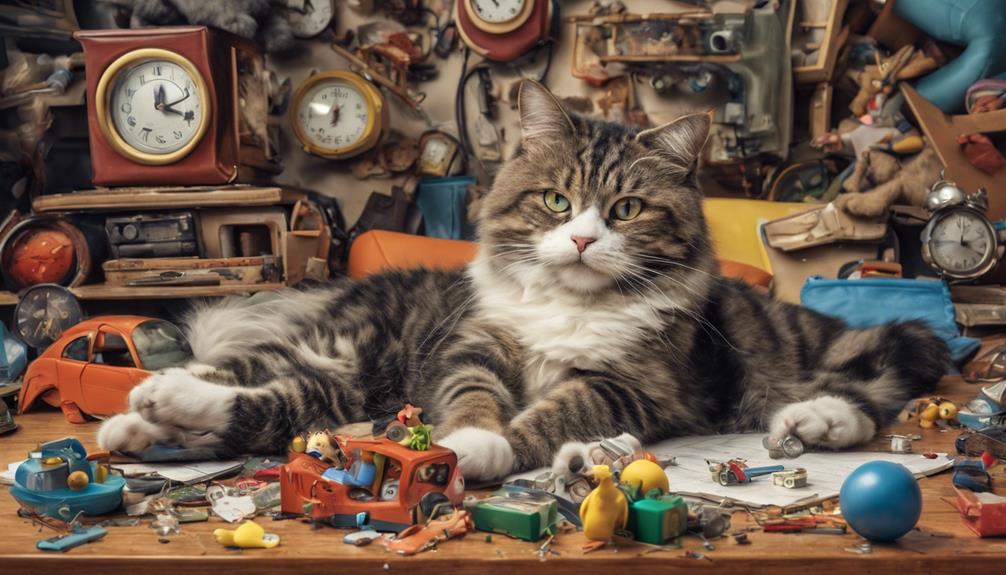
Chronic cat boredom can have detrimental effects on their health, leading to issues such as obesity, stress, and anxiety. When our feline friends lack mental stimulation and engagement in their environment, it can take a toll on their overall well-being. Here are some important points to take into account:
- Boredom can lead to overeating, causing weight gain and related health problems.
- Cats may exhibit signs of stress and anxiety when they aren't mentally stimulated enough.
- Chronic boredom can affect both the mental and physical health of our cats.
- Preventing boredom is key to ensuring our cats stay healthy and happy.
- By addressing their boredom, we can help prevent behavioral issues and enhance their quality of life.
Taking steps to keep our cats mentally engaged and entertained is essential for their health and happiness.
Remedies for Cat Boredom

To combat cat boredom effectively, we can incorporate interactive toys and engage in regular playtime sessions to stimulate our feline friends' minds and prevent boredom-related behaviors. Interactive toys, such as puzzle feeders, provide mental stimulation while satisfying their hunting instincts. These toys challenge their problem-solving skills, keeping their minds sharp and engaged. Regular playtime sessions are essential for bonding and physical activity. Cats love chasing toys like feather wands or laser pointers, keeping them active and entertained.
Creating an enriched environment is key. Offer climbing structures, scratching posts, and hiding spots to encourage exploration and play. Cats enjoy high perches to observe their surroundings and cozy spots for napping. Establishing a consistent routine for feeding, play, and interaction helps provide stability and predictability, reducing stress and boredom.
Consider introducing companion cats for social interaction. Having a feline friend can prevent loneliness and offer opportunities for play and companionship. By incorporating these strategies, we can guarantee our cats lead happy, active lives in a stimulating environment.
Interactive Toy Solutions
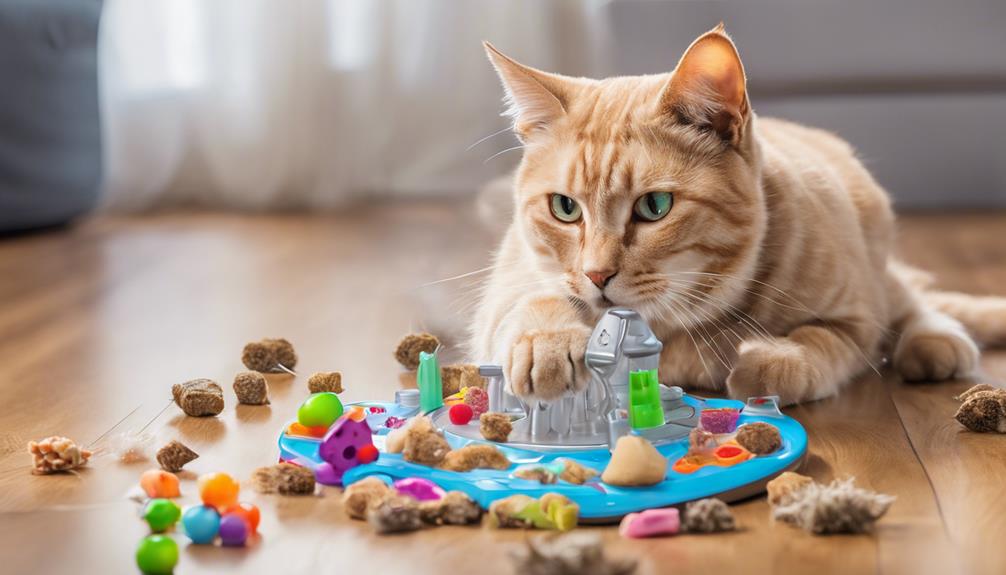
Interactive toy solutions are a great way to keep your cat entertained and mentally sharp. Mixing up the types of toys, such as fishing rod toys and puzzle feeders, can engage your cat's hunting instincts and provide both mental and physical stimulation.
Regularly rotating toys and engaging in interactive play sessions can help strengthen the bond between you and your feline friend while preventing boredom.
Toy Variety Options
When considering ways to alleviate boredom in cats, exploring toy variety options like fishing rod toys, kicker toys, and puzzle feeders can be highly effective. Cats benefit from a diverse range of interactive toys that provide mental stimulation and entertainment. Here are some toy variety options to keep your feline friend engaged:
- Ping pong balls: Offering a variety of textures and shapes can prevent boredom.
- Catnip toys: Cats may enjoy toys with catnip, but remember to rotate them regularly.
- Avoid laser pens: They can lead to frustration and behavior issues.
- Different play preferences: Provide a range of interactive toy options to cater to diverse preferences.
Playtime Engagement Techniques
Exploring various playtime engagement techniques with interactive toy solutions can effectively enhance your cat's mental stimulation and overall engagement.
Interactive toys like feather wands and laser pointers tap into your cat's hunting instincts, providing both mental stimulation and physical activity.
Puzzle feeders and treat-dispensing toys are great for encouraging problem-solving skills during meal times, keeping your cat entertained and mentally sharp.
Rotating toys regularly introduces novelty and prevents boredom, guaranteeing your cat stays interested in playtime activities.
Cat trees and climbing structures offer vertical space for exploration, satisfying your cat's natural urge to climb and perch.
Enriching Your Cats Environment
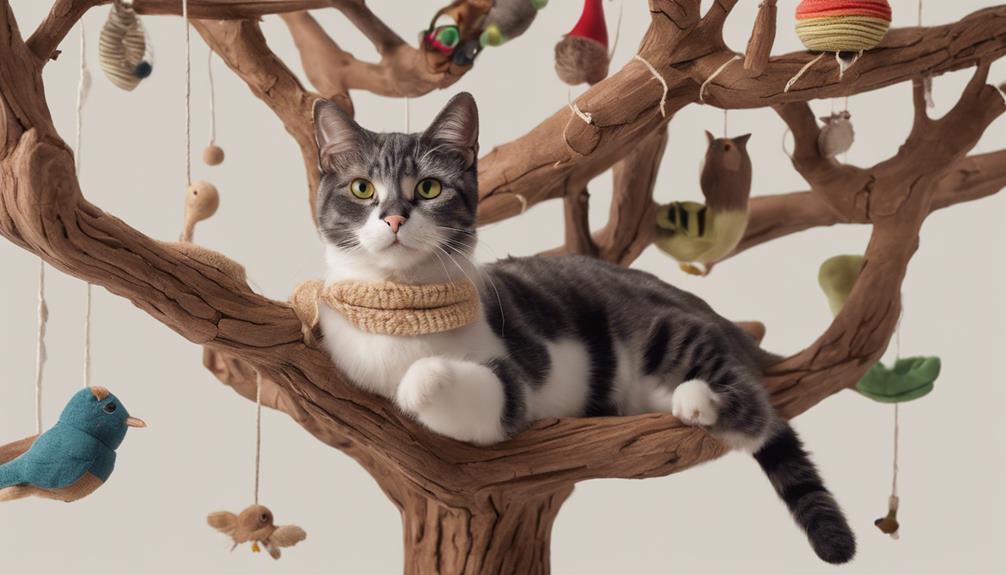
Regularly introducing new toys and providing vertical spaces can greatly enrich your cat's environment and prevent boredom. Interactive toys, such as puzzle feeders and feather wands, engage your cat's hunting instincts, providing mental stimulation.
Vertical spaces, like cat trees and shelves, offer climbing opportunities and environmental enrichment. Rotating and introducing new toys can maintain your cat's interest, keeping them engaged and preventing boredom.
Implementing a feeding routine with interactive feeders or food puzzles not only provides meals but also mentally stimulates your cat. Additionally, offering scratching posts and horizontal scratchers fulfills your cat's natural urge to scratch and explore, reducing boredom.
Social Interaction for Bored Cats

To prevent boredom in cats, regular social interaction with humans or other animals is vital. Cats thrive on companionship and play, which can greatly decrease the likelihood of boredom. Engaging in interactive play sessions with your feline friend not only provides them with mental stimulation but also helps prevent feelings of loneliness. Cats are social creatures that benefit greatly from social engagement, reducing the risk of boredom creeping in.
Lack of social interaction can lead to feelings of loneliness and boredom in cats, impacting their overall well-being. Ensuring that your cat has opportunities for social interaction is essential in enhancing their quality of life and preventing boredom from setting in. Whether it's through play sessions, spending quality time together, or introducing them to a feline companion, providing social engagement can make a world of difference for your beloved pet. Remember, a happy and socially fulfilled cat is less likely to experience boredom.
The Importance of Playtime
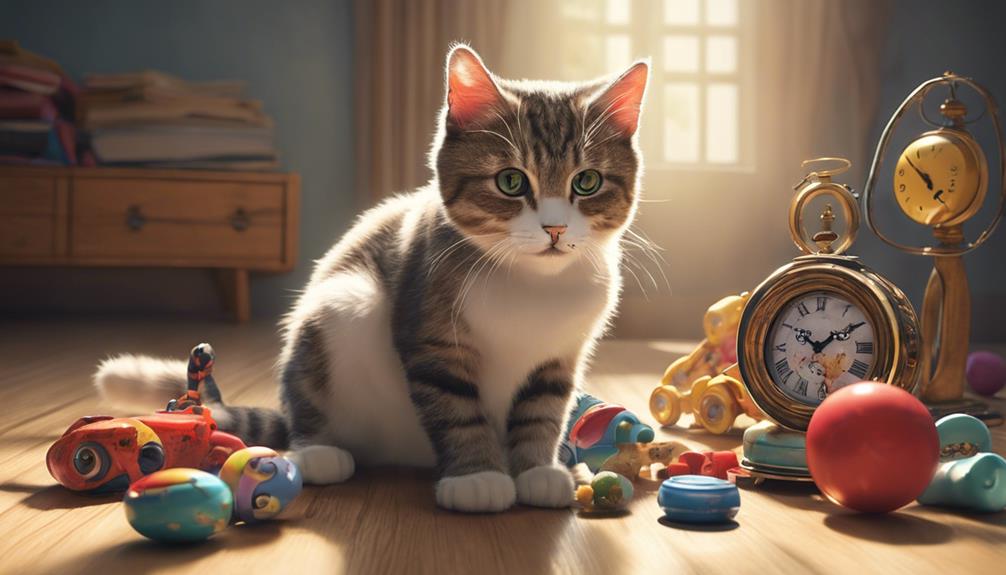
Playtime is an important aspect of a cat's routine, offering mental stimulation and fostering social bonds. When engaging in interactive play with your feline friend, you provide them with essential mental enrichment, keeping their minds sharp and preventing boredom.
- Physical and Mental Exercise: Play sessions not only provide physical exercise but also keep your cat mentally stimulated, preventing them from getting bored.
- Social Interaction: Interactive play helps strengthen the bond between you and your cat, enhancing your relationship and communication.
- Stress Relief: Playtime can alleviate stress and anxiety in cats, promoting their overall well-being and happiness.
- Preventing Boredom-Related Behaviors: Engaging in interactive play sessions can prevent boredom-related behaviors in cats, such as excessive meowing or destructive tendencies.
- Overall Well-Being: Regular playtime contributes to your cat's overall health and happiness, making it an essential part of their daily routine.
Preventing Cat Boredom
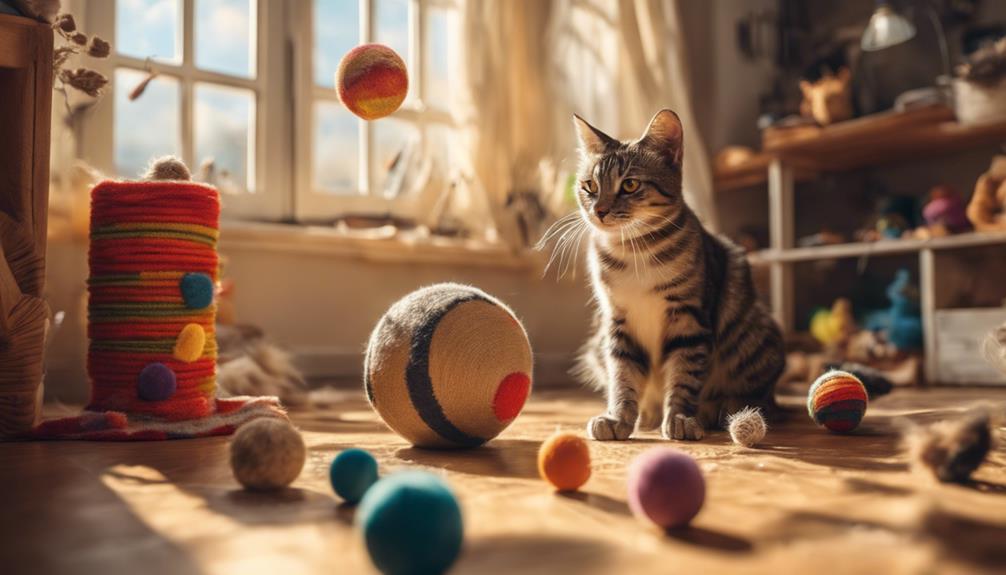
When we provide interactive toys and engage in playtime with our cats, we effectively combat boredom and enhance their overall well-being. Interactive toys, such as feather wands and puzzle feeders, keep our feline friends mentally stimulated and physically active.
Creating an enriched environment with climbing structures, cozy hiding spots, and scratching posts can also help prevent cat boredom by offering variety and stimulating their natural instincts.
Additionally, establishing a routine for feeding, playtime, and social interaction provides predictability and comfort for our cats, reducing boredom and anxiety.
Cat Boredom Prevention Tips

Engaging with interactive toys and creating an enriched environment are effective ways to prevent cat boredom and promote their well-being. To keep your feline friend mentally stimulated and happy, consider these tips:
- Interactive Toys: Providing puzzle feeders and toys that dispense treats can engage your cat's mind and prevent boredom.
- Regular Playtime: Engage in daily play sessions to prevent boredom and strengthen the bond between you and your cat.
- Enriched Environment: Set up climbing structures, scratching posts, and hiding spots to keep your cat mentally active and entertained.
- Establish Routine: Creating a consistent schedule for feeding, play, and interaction can help alleviate cat boredom by providing structure and predictability.
- Companion Cats: If possible, consider getting a companion cat for social interaction, especially for single cats who may benefit from feline companionship.
Keeping Cats Stimulated
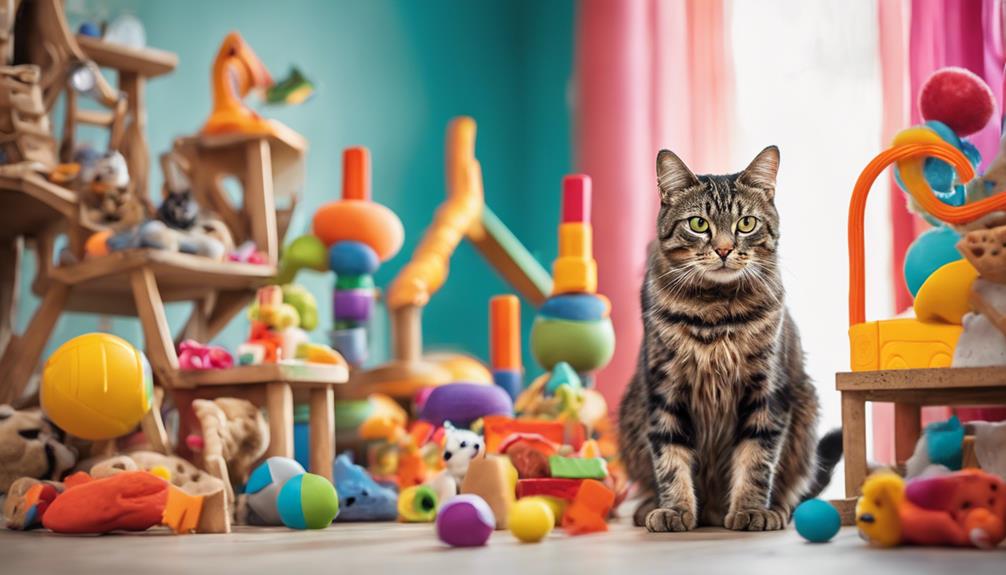
To guarantee cats are stimulated, offering a variety of interactive toys and enriching their environment with climbing structures and hiding spots is crucial. If a cat is bored, it may display signs of restlessness, excessive grooming, or even destructive behavior.
To help prevent boredom, creating a stimulating environment for your cat is vital. Consider incorporating scratching posts, window perches, and puzzle feeders to engage their natural behaviors. Rotating toys regularly and engaging in interactive play sessions daily can also go a long way in keeping your feline friend entertained.
Indoor foraging experiences, such as hiding treats around the house, can stimulate their hunting instincts and provide mental enrichment. Remember, a happy and mentally stimulated cat is less likely to develop behavioral issues. By investing time and effort in enriching your cat's environment, you can ensure they lead a fulfilling and contented life.
Frequently Asked Questions
How Do I Know if My Cat Is Bored?
We notice our cat might be bored if they groom excessively, act destructively, vocalize more, lose interest in toys, or sleep excessively. Engaging in play, enriching their environment, and establishing routines can help.
How Do I Keep My Indoor Cat Entertained?
We keep our indoor cat entertained by providing interactive toys, climbing structures, varied playthings, window views, and even a companion cat for social interaction. Engaging these activities regularly prevents boredom and keeps our feline friend happy.
How Do I Stop My Indoor Cat From Getting Bored?
To prevent indoor cats from getting bored, we provide interactive toys, rotate them often, engage in play sessions, and create a stimulating environment with climbing structures and hiding spots. A companion cat can also offer social interaction.
Does My Cat Get Bored at Night?
Nights can leave cats restless. Engaging playtime and interactive toys before bedtime can keep them entertained. An enriched environment with climbing structures and toys can prevent boredom. Our feline friends need our attention.
Conclusion
To sum up, cats can indeed get bored, leading to various behavioral indicators. By understanding these signs and implementing strategies to prevent boredom, such as engaging playtime and keeping them stimulated, we can guarantee our feline friends lead happy and fulfilled lives.
Just like us, cats need mental and physical stimulation to thrive. So, let's make sure to keep our furry companions entertained and content, creating a purr-fect environment for them to thrive in.
Paul’s love for animals knows no bounds. As a dedicated writer and animal lover, Paul brings a unique perspective to our team. His firsthand experiences with various animals enrich our content and provide valuable insights into their behavior and needs. Whether he’s sharing tips for pet care or shedding light on pressing conservation issues, Paul’s passion for animals shines through in everything he does.
Cats
7 Adorable Japanese Names for Cats
Discover 7 enchanting Japanese cat names starting with 'S', each embodying elegance, magic, and whimsy – perfect for your feline companion!
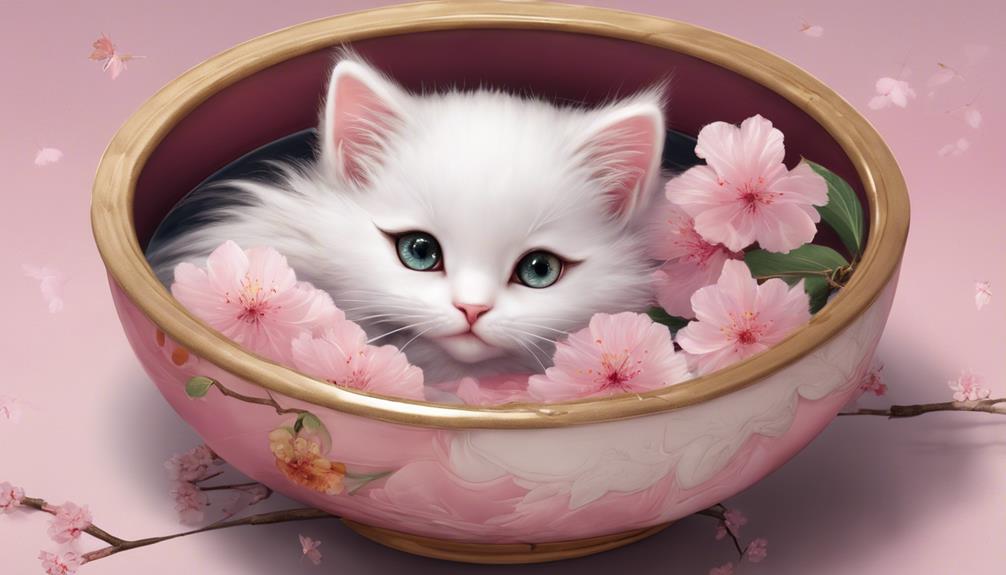
Get ready to fall in love with 7 adorable Japanese names for cats! From Cherry Blossom-Inspired names evoking elegance to Celestial names infusing cosmic magic, each name captures a unique charm. Consider Elegant Lotus names symbolizing purity or Whimsical Oceanic names reflecting the sea's beauty. Serene Bamboo names showcase resilience, while Moonlight names glow with magic. Don't forget Playful Origami names adding whimsy! These names blend tradition, beauty, and grace, perfect for your feline friend. Each name holds a special meaning and significance, embodying the essence of Japanese culture and aesthetics.
Key Takeaways
- Cherry Blossom-Inspired Names: Reflect beauty and elegance, perfect for a graceful feline companion.
- Celestial Names: Infuse cosmic magic, adding grace and mystery to your cat's identity.
- Lotus Names: Symbolize purity and sophistication, connecting to Japanese values and traditions.
- Oceanic Names: Capture the sea's beauty and playfulness, ideal for a dynamic feline personality.
- Bamboo Names: Reflect resilience and tranquility, showcasing the beauty and significance of bamboo.
Cherry Blossom-Inspired Cat Names
Cherry blossom-inspired cat names hold a special place in Japanese culture, reflecting the beauty and significance of sakura. In Japan, these names carry a sense of elegance and tradition, drawing inspiration from the fleeting beauty of cherry blossoms. Names like Sakura, Hana, and Hanami evoke feelings of grace and renewal, capturing the essence of springtime in every syllable. The cultural importance of cherry blossoms is further emphasized during cherry blossom festivals in Japan, where the blooming of sakura trees is celebrated with great joy and reverence.
Choosing a cherry blossom-inspired name for your feline companion not only adds a touch of Japanese charm to their identity but also connects them to a rich cultural heritage. It's a way to honor the beauty of nature and express admiration for the delicate yet profound symbolism of sakura. So, if you're looking for a name that exudes grace and sophistication, a cherry blossom-inspired name might be the perfect choice for your beloved cat.
Celestial Cat Names
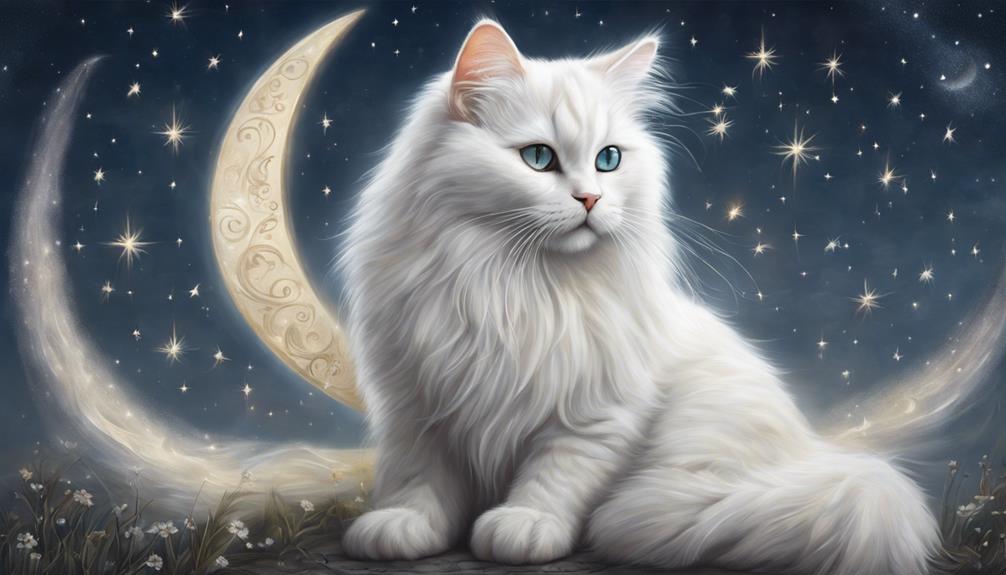
When considering celestial cat names, we're drawn to the enchanting allure of the cosmos. These starry feline titles, such as Luna or Orion, can infuse your cat's identity with a touch of heavenly magic.
Cosmic cat monikers like Nova or Nebula evoke a sense of wonder and beauty that mirrors the mysteries of the universe.
Starry Feline Titles
Inspired by the enchanting elements of the night sky, celestial cat names bring a touch of cosmic wonder to your feline friend's identity. These names aren't just labels but reflections of the grace, beauty, and unique personalities of our beloved cats.
Here are four reasons why celestial cat names are a purrfect choice for your furry companion:
- Mystery and Wonder: Celestial names like Luna or Nova evoke a sense of mystery and wonder, adding an intriguing charm to your cat's persona.
- Cosmic Charm: Naming your cat after stars, moons, or galaxies infuses a magical quality into their everyday presence.
- Graceful Reflection: Celestial cat names reflect the elegance and beauty that our feline friends possess.
- Unique Identity: These names provide a distinct and memorable identity for your cat, setting them apart with cosmic flair.
Heavenly Kitty Names
What celestial qualities make heavenly kitty names stand out as unique choices for our feline companions?
Celestial cat names draw inspiration from the heavens and celestial bodies, embodying beauty, mystery, and wonder. Names like Luna, Stella, Celeste, Nova, and Comet not only sound mesmerizing but also add a touch of magic to your cat's identity.
By choosing a celestial name, you can reflect your cat's individual personality and charm, giving them a name that truly sparkles like a star in the night sky. These names create a sense of connection to the vast universe above us, making your feline friend feel like a celestial being right in your home.
Embrace the celestial allure with these enchanting Japanese names for your beloved kitty.
Cosmic Cat Monikers
Drawing inspiration from the cosmic wonders above, celestial cat names bring a touch of magic and fascination to your feline companion's identity. When choosing a celestial name for your cat, consider the following:
- Celestial Bodies: Stars, moons, and galaxies provide rich inspiration for unique cat names like Luna and Orion.
- Sense of Mystery: These names evoke a sense of mystery and wonder, adding an enigmatic charm to your cat's persona.
- Cosmic Beauty: Names such as Nova, Nebula, and Comet reflect the cosmic beauty and uniqueness of your feline friend.
- Reflecting Personality: Celestial cat names can mirror your cat's individuality and otherworldly charm, enhancing their overall appeal.
Elegant Lotus Names for Cats

Lotus-inspired cat names can bring a touch of elegance and cultural depth to your feline companion.
Names like Hasu, Ren, and Renge draw inspiration from the graceful lotus flower, symbolizing purity and beauty in Japanese tradition.
Embracing a lotus-themed name for your cat can infuse their identity with a sense of grace and serenity.
Lotus-inspired Cat Monikers
Embracing the essence of elegance and cultural significance, choosing a lotus-inspired name for your feline companion can infuse their identity with grace and depth. In Japanese culture, lotus flowers symbolize purity, enlightenment, and rebirth, making them ideal inspirations for cat names. Here are four reasons why lotus-inspired names like Ren (蓮) or Hasu (蓮) can be a perfect fit for your cat:
- Symbol of Beauty: Lotus flowers are known for their beauty, mirroring the grace and elegance of your feline friend.
- Spiritual Significance: Naming your cat after a lotus can represent spiritual growth and inner peace.
- Cultural Depth: Adding a lotus-inspired name can connect your cat to Japanese traditions and values.
- Elegance and Sophistication: These names evoke a sense of sophistication and refinement, reflecting your cat's unique qualities.
Petite Floral Feline Names
Our selection of petite floral feline names captures the essence of elegance and grace, embodying the purity and beauty symbolized by the lotus flower. Japanese cat names with meanings inspired by lotus flowers offer a unique touch of sophistication and refinement to your feline companion's identity.
These names, reflecting the delicate nature of cats, evoke tranquility and serenity, enhancing the bond between you and your pet. By choosing a lotus-inspired name, you connect your cat to the peaceful essence of nature, adding a sense of grace to their character.
Each name carries a deeper significance, symbolizing beauty and purity, aligning perfectly with the elegance of your Japanese cat. Embrace the beauty of the lotus with a name that reflects the serene and exquisite nature of your feline friend.
Whimsical Oceanic Cat Names

Indulge in the charm of whimsical oceanic cat names that capture the essence of the sea's beauty and mystery. When selecting a name for your feline friend, consider the tranquility and vastness of the ocean as inspiration.
Here are four oceanic-inspired Japanese cat names to add a touch of enchantment to your pet:
- Kai – Meaning 'ocean' in Japanese, this name embodies the deep, boundless nature of the sea, perfect for a cat who exudes a sense of freedom and fluidity.
- Mizu – Translating to 'water,' Mizu symbolizes the ever-flowing and adaptable qualities of the ocean, ideal for a cat with a playful and dynamic personality.
- Sora – Representing 'sky,' Sora reflects the interconnectedness of the heavens and the sea, making it a fitting choice for a cat who loves to explore and dream.
- Nami – Signifying 'wave,' Nami captures the rhythmic and soothing movements of the ocean, suitable for a cat with a calming presence and graceful demeanor.
Serene Bamboo Names for Cats

Bamboo-inspired names for cats offer a serene and meaningful way to reflect the resilience and tranquility present in Japanese culture. In Japan, bamboo symbolizes flexibility and strength, making it a perfect source for unique cat names.
Takeo, meaning 'bamboo man,' Takeda, signifying 'bamboo rice field,' or Chikako, representing 'child of a thousand bamboos,' all showcase the beauty and significance of bamboo in Japanese cat names. These names bring a touch of nature, simplicity, and elegance to your feline companion, aligning perfectly with their graceful demeanor.
Enchanting Moonlight Cat Names
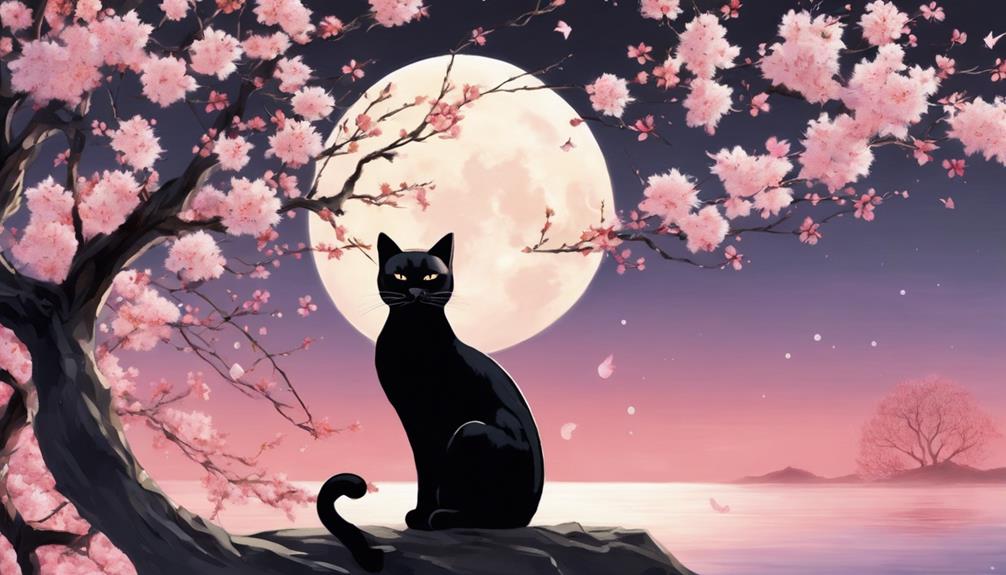
Shroud your feline friend in a mantle of enchantment with these mesmerizing Moonlight Cat Names. Moon-inspired Japanese names carry a sense of mystery and elegance, perfect for capturing the beauty and tranquility of the night sky. Embrace the celestial charm and grace with these enchanting names:
- Tsuki – Meaning moon, this name encapsulates the serene glow and magic of the moonlit nights, bringing a touch of celestial beauty to your cat's persona.
- Luna – A popular moon-related name, symbolizing the celestial glow and grace that radiates from the moon, adding an air of mystique to your cat's identity.
- Yoru – Translating to night, this name reflects the enchanting and magical aura of the moonlight, evoking a sense of peace and tranquility.
- Hikari – Representing light, this name embodies the gentle radiance of the moon's glow, illuminating your cat's presence with a celestial charm.
Choose a moonlight-inspired name to infuse your beloved feline companion with a touch of celestial allure.
Playful Origami Cat Names

Let's explore the charm and creativity of Playful Origami Cat Names, inspired by the intricate art of Japanese paper folding. Naming your Japanese cat after an origami design can be a delightful way to capture their grace and elegance. These names not only reflect qualities like creativity but also add a touch of whimsy and playfulness to your feline friend's persona.
Choosing an origami-inspired name for your cat is a unique and creative decision that showcases your admiration for Japanese culture. Names like 'Kiku' (chrysanthemum), 'Sakura' (cherry blossom), and 'Tsuru' (crane) are popular choices that embody the beauty and intricacy of both origami and your beloved pet.
Embrace the art of origami by giving your cat a name that reflects the beauty and creativity of this traditional Japanese craft. Your playful origami cat won't only have a unique identity but also a name that symbolizes the elegance and charm they bring into your life.
Frequently Asked Questions
What Are Cute Japanese Pet Names?
We love sharing cute Japanese pet names like 'Mei' (sprout) and 'Kirei' (pretty). They're endearing choices that capture the charm of our furry friends. Sweet names like 'Chisai Tori' (little bird) add a touch of cuteness to our pets.
What Is the Cutest Cat Name?
When deciding on the cutest cat name, we explore endearing qualities that resonate with our hearts. It's a personal journey of discovery, seeking a name that encapsulates the essence of charm and love.
What Do Japanese Call Their Cats?
We call our feline friends in Japan 'neko,' a term of endearment. Japanese pet owners often use sweet names like 'nyanko' or 'nyanko-chan' for their cats. It reflects our affection for these adorable creatures.
What Is the Japanese Name for Lucky Cats?
We call lucky cats 'Maneki-Neko.' This beckoning feline brings good luck and fortune. The raised paw symbolizes beckoning fortune. It's a popular charm in Japan, believed to attract positive energy and keep evil spirits at bay.
Conclusion
To sum up, selecting a Japanese name for your cat can bring a hint of sophistication and allure to their identity. Just like a fragile cherry blossom tree, these names can blossom with beauty and elegance.
Whether you favor celestial, oceanic, or bamboo-inspired names, there are numerous choices to match your feline friend's personality.
So, why not give your furry companion a name as distinctive and delightful as they are?
Paul’s love for animals knows no bounds. As a dedicated writer and animal lover, Paul brings a unique perspective to our team. His firsthand experiences with various animals enrich our content and provide valuable insights into their behavior and needs. Whether he’s sharing tips for pet care or shedding light on pressing conservation issues, Paul’s passion for animals shines through in everything he does.
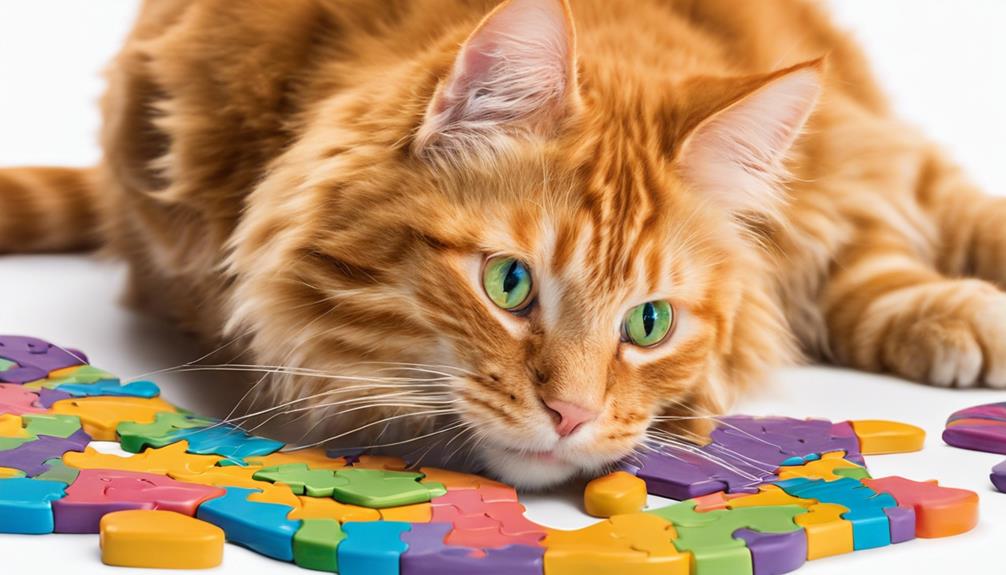
When it comes to keeping your feline friend entertained and mentally sharp, puzzle toys for cats are a must-have. The Interactive Cat Feeder Toy engages your cat's hunting instincts, while the Treat Dispensing Puzzle Ball challenges their skills with tasty rewards. The Indoor Hunting Feeder Toy mimics natural foraging behavior, preventing boredom and promoting a healthier lifestyle. The Interactive Treat Maze Toy offers an enriching feeding experience, encouraging your cat to problem-solve for hidden treats. Finally, the Puzzle Board Game provides mental stimulation and prevents destructive behaviors. These engaging toys cater to your cat's natural instincts and cognitive development.
Key Takeaways
- Interactive Cat Feeder Toy engages cats mentally and physically with varying difficulty levels.
- Treat Dispensing Puzzle Ball challenges cats' natural instincts and provides mental stimulation with adjustable difficulty.
- Indoor Hunting Feeder Toy mimics natural foraging behavior, preventing boredom and promoting a healthier lifestyle.
- Interactive Treat Maze Toy encourages cats to use their hunting instincts with adjustable difficulty levels.
- Puzzle Board Game offers mental stimulation, problem-solving skills, and various difficulty levels for indoor cats' entertainment.
Interactive Cat Feeder Toy
We find that the interactive cat feeder toy is a valuable tool for engaging our feline friends both mentally and physically.
This puzzle feeder toy taps into the natural hunting and foraging instincts of cats, providing mental stimulation while satisfying their physical needs.
With different difficulty levels, it challenges cats at various skill levels, ensuring they stay entertained and active.
The use of 100% recyclable cardboard and certified metal-free inks not only prioritizes sustainability but also guarantees the safety of our beloved pets.
Treat Dispensing Puzzle Ball
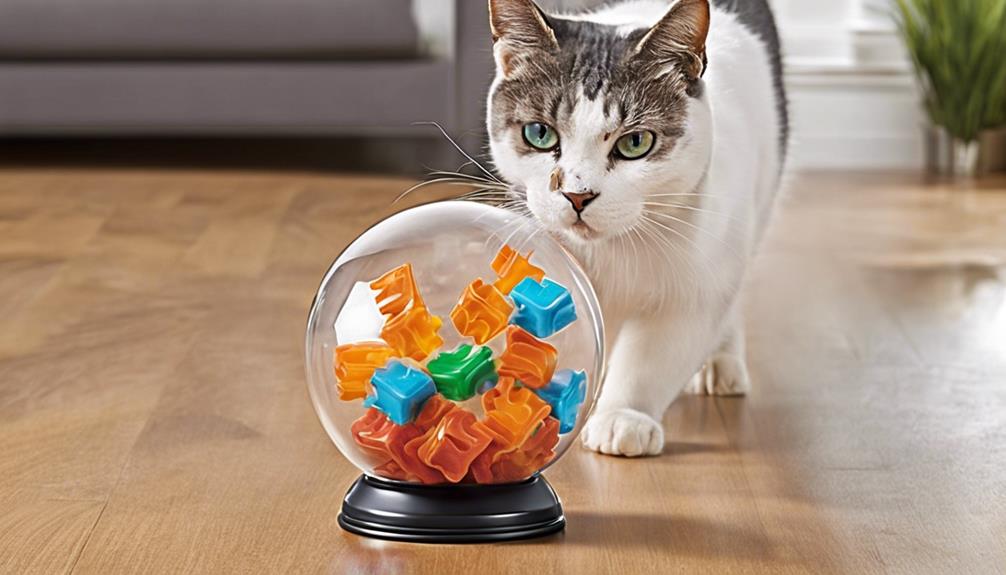
Enhancing feline playtime and mental stimulation, the Treat Dispensing Puzzle Ball is a popular interactive toy that dispenses treats as cats engage with it.
This interactive puzzle challenges cats to use their natural instincts by rolling the ball to release tasty surprises, encouraging their hunting instinct.
Not only does it provide physical activity, but it also offers mental stimulation, keeping your cat entertained for hours.
Adjusting the difficulty level of the treat dispenser allows owners to tailor the experience to their cat's abilities and maintain their interest over time.
Cat puzzle toys like the Treat Dispensing Puzzle Ball aren't only fun but also enriching, providing a way for your feline friend to stay engaged and active.
These food puzzles are suitable for cats of all ages and can be a valuable addition to their playtime routine, promoting both physical and mental well-being.
Indoor Hunting Feeder Toy
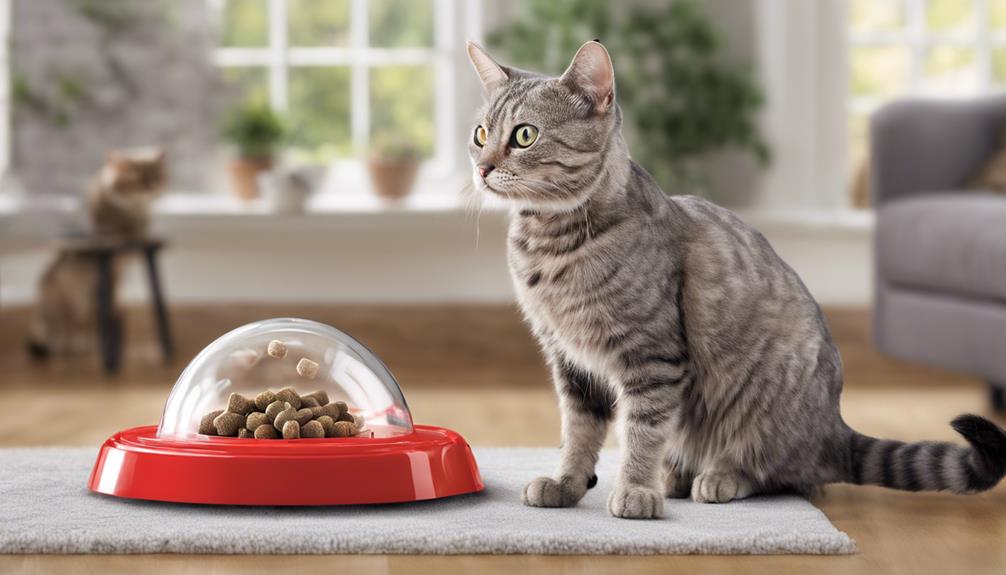
Designed to engage cats in natural foraging behavior, the Indoor Hunting Feeder Toy provides a mental challenge by hiding treats or food in various compartments. This interactive puzzle feeder encourages cats to use their instincts, keeping them mentally stimulated and physically active.
By mimicking the hunt for food, this toy offers a fun way for cats to stay entertained while promoting a healthier lifestyle indoors. The Indoor Hunting Feeder Toy is an excellent tool for preventing boredom and behavioral issues in cats of all ages.
It not only provides a mental challenge but also offers physical stimulation as cats work to access the hidden treats. With this puzzle feeder, cats can enjoy the thrill of the hunt in a safe and controlled environment, satisfying their natural instincts.
Keeping your feline friend engaged with the Indoor Hunting Feeder Toy can lead to a happier and more fulfilled indoor life.
Interactive Treat Maze Toy

The Interactive Treat Maze Toy engages cats in a challenging and rewarding feeding experience by encouraging them to use their natural hunting instincts to find hidden treats within the maze. This interactive cat toy is perfect for our feline friends who are food motivated and love a good puzzle.
By providing mental stimulation and adjustable difficulty levels, this toy keeps cats entertained and mentally engaged throughout the day. Not only does it tap into their hunting instincts, but it also promotes their overall well-being by offering a fun way to stay active.
Crafted from recycled cardboard, this environmentally friendly treat dispensing toy is safe for cats to interact with, giving pet owners peace of mind. It's an excellent addition to any cat's toy collection, offering a blend of entertainment and enrichment. With the Interactive Treat Maze Toy, cats can enjoy a mentally stimulating experience that caters to their natural instincts in a safe and engaging manner.
Puzzle Board Game
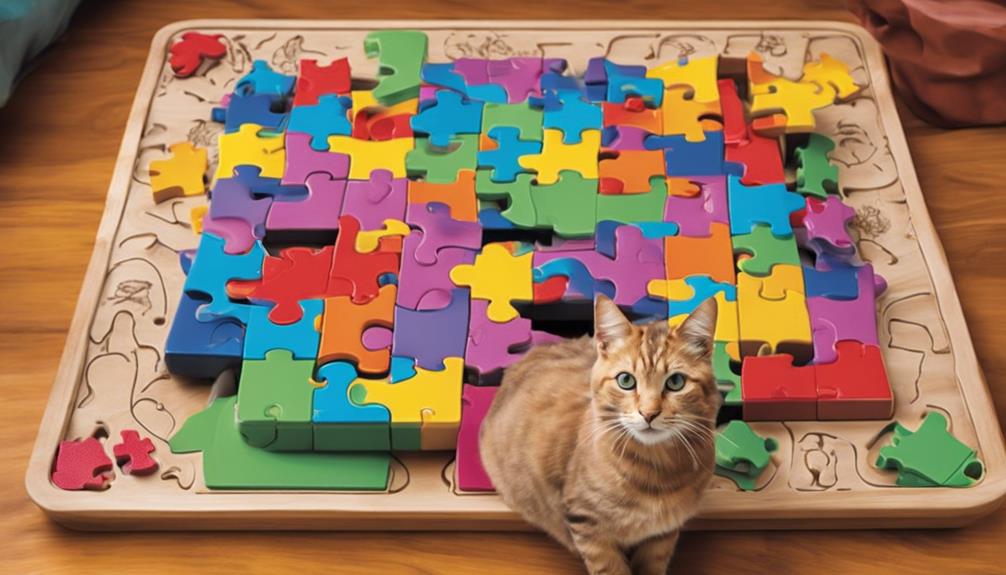
Puzzle board games provide cats with mental stimulation and engagement, encouraging them to showcase their problem-solving skills and natural hunting instincts. These games serve as a boredom buster, keeping your cat active both physically and mentally. By using the best cat puzzles, interactive toys, and treat toys, puzzle board games can help improve your cat's skills in hunting and foraging while preventing destructive behaviors caused by boredom.
When selecting a puzzle board game for your feline friend, consider options like puzzle feeders with non-slip rubber bottoms to prevent sliding during play. These toys come in various difficulty levels, allowing you to choose the one that best suits your cat's abilities. As your cat interacts with the puzzle board game, their cognitive skills will improve, providing entertainment and exercise, especially for indoor cats.
Frequently Asked Questions
Are Puzzle Games Good for Cats?
Yes, puzzle games are good for cats. They stimulate natural instincts, prevent boredom, and enhance cognitive abilities. Engaging with these toys fosters healthier eating habits and strengthens the bond between us and our feline companions through interactive play.
What Kind of Toys Do Cats Enjoy Playing With?
We cats adore toys that challenge our minds and instincts, like puzzle feeders. These toys keep us engaged, prevent boredom, and mimic hunting behaviors. They provide mental stimulation, encourage physical activity, and overall enrich our lives.
How to Make an Interactive Cat Toy?
We make interactive cat toys with simple materials like cardboard or paper bags. Adding treats or toys keeps our cats engaged. Hidden compartments and different textures enhance the toy. These DIY toys provide mental stimulation and physical activity for our feline friends.
What Is the Best Puzzle Ball for Cats?
The best puzzle ball for cats is the PetSafe SlimCat Meal-Dispensing Cat Ball. It holds up to 85 grams of dry food, promotes physical activity, and mental stimulation. With adjustable settings, it suits different cats, making feeding enriching.
Conclusion
To sum up, puzzle toys for cats aren't only engaging but also provide mental stimulation and physical activity for your furry friend. These toys not only keep your cat entertained but also help satisfy their natural hunting instincts.
Just like pieces of a puzzle fit together, these toys fit perfectly into your cat's routine, keeping them happy and healthy.
So, why not treat your cat to one of these interactive toys and watch them pounce and play to their heart's content!
Paul’s love for animals knows no bounds. As a dedicated writer and animal lover, Paul brings a unique perspective to our team. His firsthand experiences with various animals enrich our content and provide valuable insights into their behavior and needs. Whether he’s sharing tips for pet care or shedding light on pressing conservation issues, Paul’s passion for animals shines through in everything he does.
-

 Vetted2 months ago
Vetted2 months ago15 Best Cat Foods for Managing Hyperthyroidism – Vet Approved and Feline Friendly
-

 Animal Facts2 months ago
Animal Facts2 months agoSpring Animals: A Guide to Seasonal Wildlife
-

 Vetted2 months ago
Vetted2 months ago15 Best Dog Foods for Kidney Disease – Expert Recommendations for Your Pet's Health
-

 Cats7 months ago
Cats7 months agoTop 5 Cat Breeders in Arkansas: A Guide
-

 Vetted2 months ago
Vetted2 months ago15 Best Fresh Dog Food Delivery Services for Your Pup's Health and Happiness
-

 Rabbits2 months ago
Rabbits2 months agoExploring Rabbit Holes: What Do They Look Like?
-

 Pets2 months ago
Pets2 months agoLatest Pet Statistics in US – Trends & Insights in 2024
-
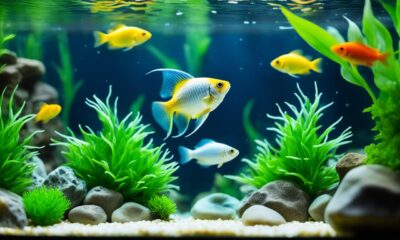
 Fish2 months ago
Fish2 months agoKeeping Your Sucker Fish Thriving at Home





















